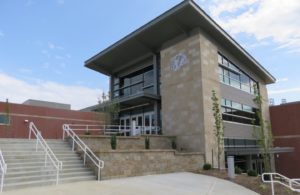Kansas school districts lawyer up after one district closes academic center, sending more than 100 students to other schools
(The Sentinel) – The Wetmore Academic Center (WAC) buildings are vacant as its former students prepare to return to classes elsewhere this fall, but there is plenty of activity in legal…

(The Sentinel) – The Wetmore Academic Center (WAC) buildings are vacant as its former students prepare to return to classes elsewhere this fall, but there is plenty of activity in legal maneuverings as USD 113 determines the financial fate of WAC, which the district closed earlier this year, and of the area schools accepting its student body.
It’s expected that 110 of the 122 former WAC students will attend Jackson Heights USD 335. An email from Superintendent Jim Howard estimates the substantial additional costs his district will assume in integrating the former Wetmore students:
- Transportation Costs: $110,000. Approximately $60,000 for additional driver salaries, $30,000 for the purchase of two used buses, and around $10,000-$20,000 in added fuel.
This includes additional bus routes, fuel costs, hiring drivers, and maintaining the increased fleet. We added four routes to help with the influx of students needing transportation. This does not include the purchase of a new bus for around $120,000 because it was a purchase we were considering anyway and the Wetmore students were only a factor in the purchase. The rest are direct costs for new students.
- Food Cost: $50,000. We have around a 22-25% increase in enrollment and expect around this amount in food.
- Classroom Space and Facilities: $30,000. While we did the work in-house, adding additional classroom space in both buildings was expensive.
- Teacher and Staff Recruitment: $165,000. We hired 1.5 teachers, three paras, and an additional support person for transposition.
- Curriculum and Educational Resources: $30,000. We added more curriculum materials, purchasing new textbooks, digital resources, and classroom supplies.
- Community Engagement / Administrative Cost: $10,000. Holding meetings, creating informational materials, and maintaining open communication channels with parents and community members.
Eight students will attend Vermillion USD 380, and four will enroll at USD 322 Onaga.
However, USD 113’s controversial plan to keep about 75% of the state aid has each side “lawyering up” to negotiate a settlement each can support.
Financial analyst and Wetmore alumna Analyssa Noe previews the contentious issues:
- Due to a gap in the school funding formula, the receiving schools will not receive any base state aid for the students who will be transferring into their districts (for example, USD 335 should receive $5,088 x 110 students = $560,000)
- USD 335 in particular has incurred significant costs to take on the Wetmore students; including hiring teachers and staff, many are former Wetmore teachers, and purchasing supplies such as tables, chairs, and desks to accommodate the influx of students
- USD 113 has declined, instead offering to provide a one-time payment of about $138,000 to assist with the transportation costs.
The funding gap is likely more than $750,000 for USD 335 because Noe’s calculation is just on base aid; students also qualify for a variety of weightings like at-risk, transportation, etc.
The school funding formula allows districts to use the higher of the two previous years’ enrollment for funding purposes, but not current enrollment. USD 113 can therefore receive funding for the former Wetmore students for two years, but USD 335 cannot count the Wetmore transfers this year. Next year, both districts can receive funding for the transfers and thereafter, only USD 335 would receive funding for them.
Writing in the Sabetha Herald in a May 9th editorial, and responding to criticism USD 113 was “closing a school and pocketing the cash”, Superintendent Todd Evans deflected blame for the controversy toward the Kansas Legislature’s school funding formula:
“I believe that Kansas legislators are very astute. I believe it is possible that they considered this as a possibility and considered it similar to the consolidation incentives contained in KSA 72-5141. Why would legislators be willing to incentivize the closure of buildings? This leads to increased efficiencies that result in the State saving education dollars. A specific example of this was mentioned in the 2015 Kansas Legislative Post Audit Report on the efficiency of Prairie Hills, USD 113. It was reported ‘Additionally, (to the district saving money on the Wetmore closure) the state would save around $129,000 annually in KPERS (Kansas Public Employees Retirement System) contributions if the district took this action’.”
Dave Trabert, CEO of the Sentinel’s parent company, Kansas Policy Institute, says there is no legislative history that supports Evans’ claims.
“School districts asked the Legislature to provide funding based on the higher of the two previous years rather than the current year because they said it was too hard to budget otherwise. That’s a pretty weak excuse and the change hurt districts that are growing, but that’s it. It had nothing to do with encouraging districts to close schools as Todd Evans suggests.”
Governor Kelly this year vetoed part of the school funding bill reducing the “Lookback” to one year because she found it penalized rural schools with declining enrollment. Rep. Adam Thomas introduced HB 2040 this year to allow growing districts to use current enrollment for funding purposes if it is higher than past enrollment, but it didn’t get out of committee.
Attorney Chad Tenpenny represents USD 113:
“After a long, systematic and painful process that involved significant community input, the Board, unanimously, made the very difficult decision to close the Wetmore school. Following Kansas law, the Prairie Hills school district is prepared to educate all students who are enrolled this Fall.”
Attorney for the other districts Josh Ney did not respond to our request for comment.
Katie Whisman with the Wetmore Community Action Association says the WAC example is indicative of the plight of rural schools:
“We have seen, time and time again, lopsided boards who are still looking for ways to find more money for their districts make decisions to close smaller, rural schools. When they do this, a few things happen: 1) they are willing to eliminate teachers and entire communities that used to be part of the whole; 2) under the current funding formula, they get to keep “lookback” funding for those students for 2 years; and 3) they cleave off territory in their district that reduces their enrollment numbers and increases the low-enrollment weighting the district receives in state aid. For that same reason, neighboring districts are reluctant to accept students from closed schools – because it changes their low-enrollment weighting and impacts their funding. The result is rural communities that have become islands with a K-12 education vacuum, uncertain of where their children will go or who will educate them next year. This is what seems to be happening in the rural communities”



